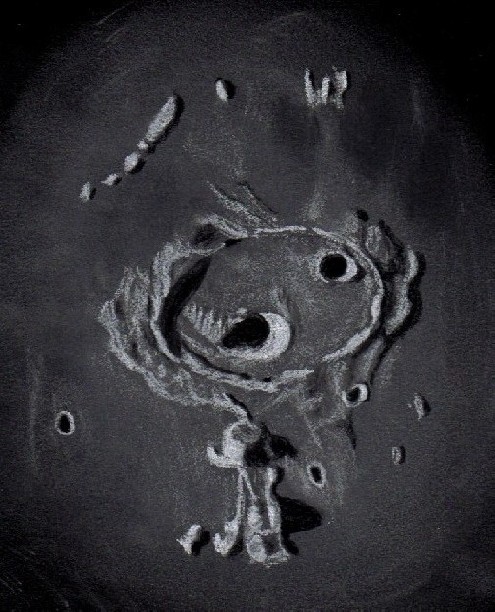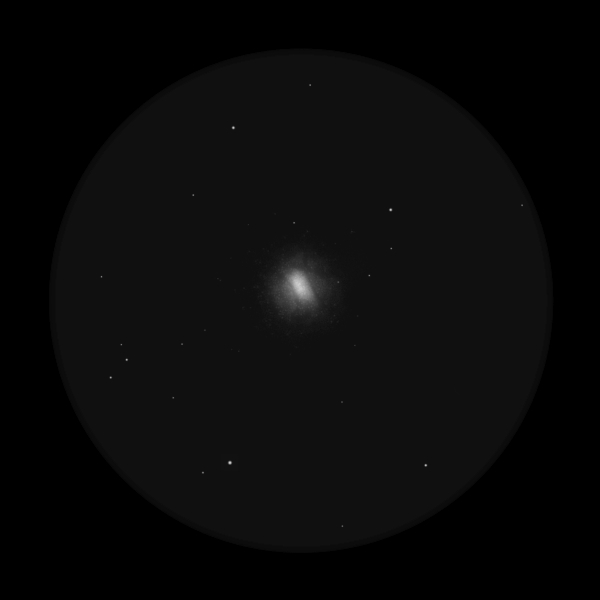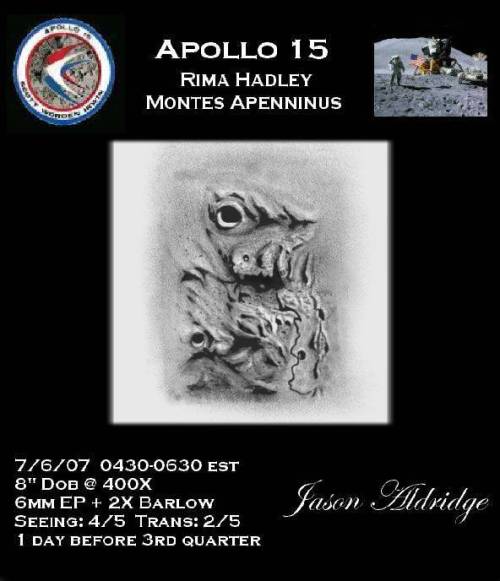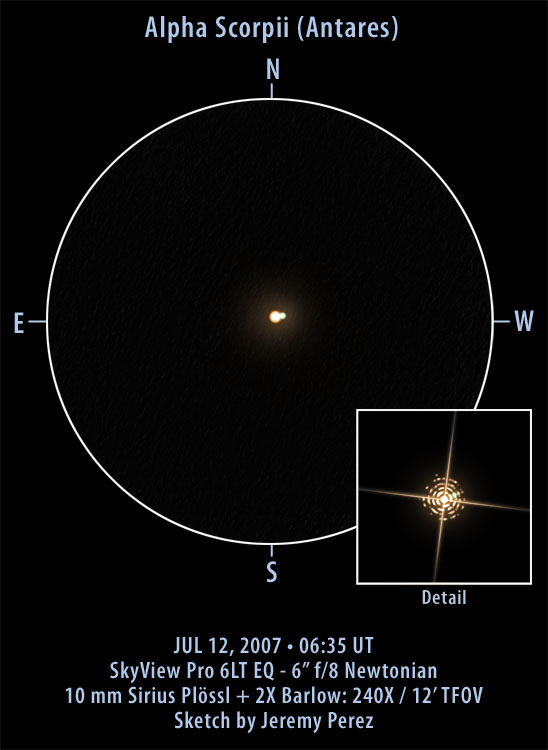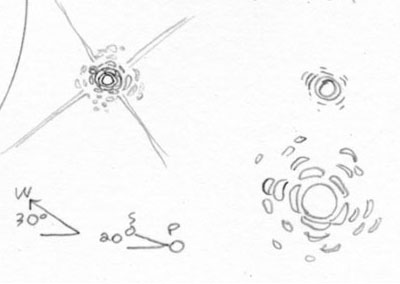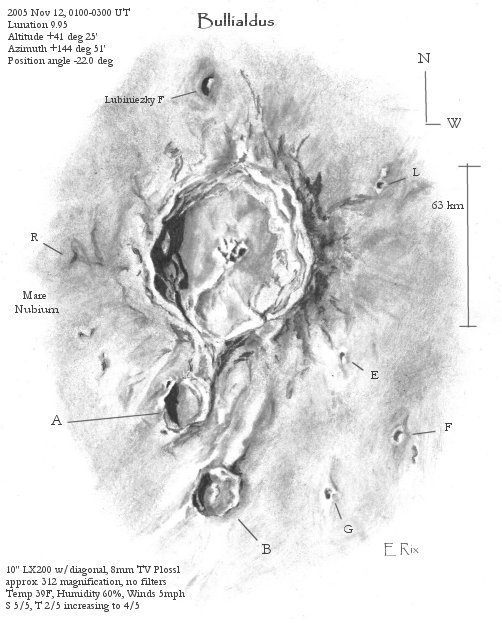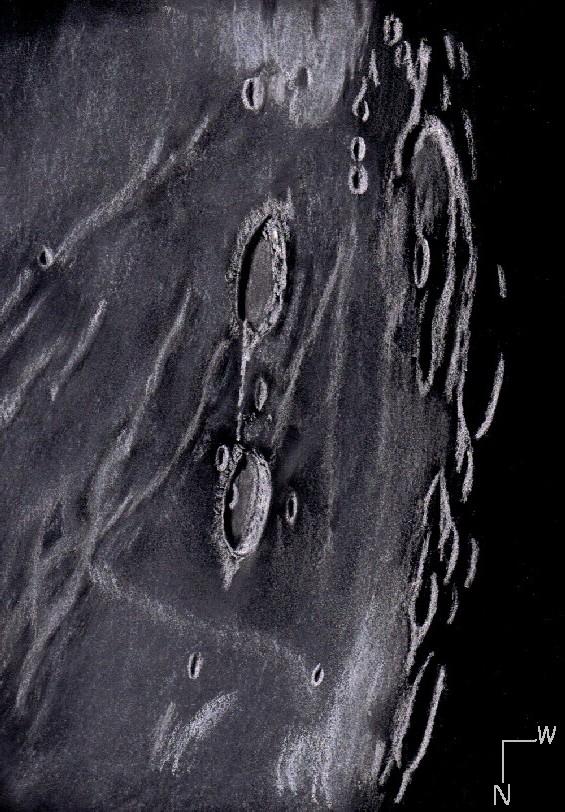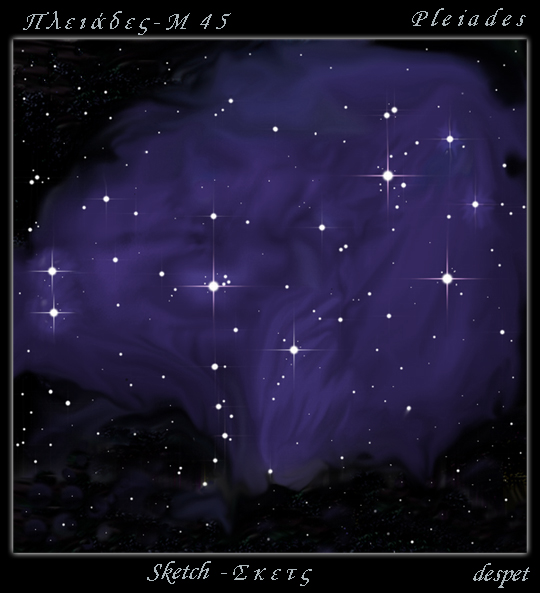Day eight of a lunation is a favorite time to witness interesting light and shadow
play along the terminator from north to south. Crater Cassini is a very eye
catching crater and with a diameter of nearly 60km it is an attractive target for
telescopes of all sizes. At more than 3.5 billion years of age, Cassini is an old
battered nearly circular crater on the eastern edge of Mare Imbrium. The lava
basin around the crater appears mostly smooth and relatively dark. The ejecta
blanket immediately around this crater has an odd almost melted appearance. The
crater is shallow and the floor appears to be higher in elevation than the
surrounding mare; although this may be illusionary. Two large craters are visible
on Cassini’s floor. Crater A is the largest at 15 km.and the smaller B is about 9
km in diameter. Beyond the crater I sketched craters F, M and W all about 7 km in
size.
Between Crater A on the floor of Cassini and the nearest inner wall is a series of
rilles and hills that resemble fish bones. At other times I have seen a nice dome
to the lower left (northeast) of Cassini but with the crater too far from the
sunrise terminator I could not pick it out.
Sketching:
For this sketch I used: black Strathmore 400 Artagain paper, white and black Conte’
pastel pencils and a blending stump.
Telescope: 10 inch f/ 5.7 Dobsonian and 6 mm eyepiece 241X
Date: 3-27-2007 12:15-1:20 UT
Temperature: 20° C ( 69° F)
Partly cloudy, calm
Seeing: Antoniadi III
Colongitude 8.5 °
Lunation 8 days
Illumination 63.5 %
Frank McCabe
Glorious Globular
Summer is approaching, the nights have become grey. But I do not stop observing.
Here is an impression of M3. I had fun teasing out as much detail as possible.
Globulars are difficult to render. The mind might see patterns that aren’t there. I
tried to remain objective. Lots of faint stars were present in the outer region of
the halo. I noticed some dark lanes in the halo, and the core looked elongated too.
I hope you like the view.
Date : June 5, 2007
Time : 22.30UT
Scope : ETX 105/1470
Meade 25mm and 15mm SP
Power : x66 to x100
FOV: 35′
Filter : none
Seeing : 2.5/5
Transp. : 2/5
Nelm : 4.9
Sketch Orientation : N up, W right.
Digital sketch made with PhotoPaint, based on a raw pencil sketch.
Best Regards,
Rony De Laet
http://www.geocities.com/rodelaet, my personal website.
White Light Delight
Solar Photosphere: The Beginning of NOAA 10966
Faculae were on both the eastern and western limbs, showing up with nice contrast
against the limb darkening. Within the eastern facula, the spot in NOAA 10966 was
hiding so well that I nearly missed it all together. After scanning the entire disk,
I finally picked up this little pore. No signs of penumbra. Faint granulation was
observed, though.
I’ve been using copy paper and a #2 pencil for my multiple white light filter
observations. Blending done with my finger.
Erika Rix
Zanesville, Ohio USA
A Birthday Tribute
On August 5th 1971 the Astronauts of Apollo 15, David Scott, James Irwin, and
Alfred Worden were coming home. It was the 11th day of the mission, and the 2nd day
of their voyage back to Earth after a successful mission to the lunar surface.
Six days earlier on July 30th, Apollo 15 Commander David Scott and Lunar Module
(LM) pilot James Irwin had landed in the Rima Hadley/Montes Apenninus region of the
Moon in the Lunar Module Falcon. “OK, Houston. The Falcon is on the Plain at
Hadley.”, said David Scott upon touchdown. The Command and Service Module (CSM)
pilot, Alfred Worden continued in lunar orbit in the CSM Endeavour and conducted
scientific experiments. While on the lunar surface, Scott and Irwin made three
moonwalk Extra Vehicular Activities (EVAs), becoming the 7th and 8th men to walk on
the Moon. During the EVAs which totalled 18 hours, 35 minutes, they covered 27.9
km, and collected 76.8 kg of rock and soil samples. They also took photographs, set
up the Apollo Lunar Surface Experiments Package (ALSEP), and performed other
scientific experiments. This time the Astronauts didn’t just walk on the Moon, for
this was the first mission to employ the Lunar Roving Vehicle. Scott and Irwin used
the Rover to
explore regions within 5 km of the LM landing site. After the final EVA, David
Scott performed a televised demonstration of a hammer and feather falling at the
same rate in the lunar vacuum.
The LM lifted off from the Moon on August 2nd after 66 hours, 55 minutes on the
lunar surface. Once the Falcon docked with Endeavor, the lunar samples and other
equipment were transferred from the LM and it was jettisoned after a one orbit
delay.
The LM Falcon impacted the Moon on August 3rd, 93 km west of the Apollo 15 ALSEP
site. It had an estimated impact velocity of 1.7 km per second.
On August 4th, after Apollo 15 underwent an orbit-shaping maneuver, a scientific
subsatellite was spring-launched from the Scientific Instrument Module (SIM) bay
into lunar orbit. The Apollo 15 crew began the transearth injection on the next
orbit which started their long journey home.
The next day, August 5th, Alfred Worden stepped into the black vacuum 196,000 miles
from the earth to become the first man ever to take a floating excursion outside
his craft in interplanetary space. The Apollo 15 astronauts, in prearranged
collaboration with Soviet and Dutch astronomers, were trying to observe what some
scientists suspect are “black holes” in the sky.
Meanwhile, back on Earth, Niel Armstrong was celebrating his 41st birthday. In
Houston not too far from Mission Control, Credence Clearwater Revival was jamming
at the Coliseum . Across the Atlantic Ocean in Munich Germany, An American Soldier
and his wife (Justin and Janet Aldridge) were celebrating the birth of their first
child. They named him Jason.
Two days later on August 7th, the Apollo 15 Astronauts splashed down in the Pacific
Ocean, 330 miles north of Honolulu, Hawaii and 6.1 mi from the recovery ship USS
Okinawa. 16 months later, Apollo 17 Commander Eugene Cernan would be the last man
to walk on the Moon.
A child of Apollo, Jason would grow up with dreams of traveling to the Moon. He saw
the color photographs of Mars that returned from the Viking Missions, and he knew
that someday he would visit Mars as well. He watched as the Voyager spacecraft flew
past Jupiter, Saturn, Uranus, and Neptune, and he knew that Man would explore the
solar system and beyond in his lifetime.
Today I am 36 years old. The dreams I had as a child are all but a fond memory now.
No Human has been back to the Moon, and there have been no manned missions beyond
Earths orbit. NASA plans to return to the Moon by 2018, almost 50 years after Niel
Armstrong first set foot there. I think my feelings about this matter are best
described in the words of Apollo 15 Commander, David R Scott:
“As I stand out here in the wonders of the unknown at Hadley, I sort of realize
there’s a fundamental truth to our nature, Man must explore . . . and this is
exploration at its greatest.”
I would like to dedicate this lunar sketch to the brave men of Apollo 15, David R
Scott, James B Irwin, and Alfred M Worden. I am honored to have been born during
their historic mission.
Jason Aldridge
PS: Happy Birthday Niel Armstrong!
*Sources: NASA NSSDC Master Catalog Display: Spacecraft, Apollo Flight Journal, New
York Times articles from 8/6/1971, Credance Clearwater Revival official web site.
Sketching Materials: 0.5mm Mechanical Graphite Pencil, Strathmore Windpower Sketch
Paper, MGI Photosuite III software for post processing.
Multiple Stars – Split Personalities
Due to my newly found enthusiasm for observing, measuring and, of
course, sketching Double and Multiple Star Systems, I’ve decided to
present a selection of some of the most well-known star systems of that
kind.
Clockwise starting in the upper left corner, you will find Mizar and
Alkor in Ursa major, already known since ancient times. The upper right
corner shows Albireo, the indicator of late summer / early autumn and
for many observers one of the best double stars in the sky. The lower
right corner shows Epsilon lyrae, the famous double Double, I got the
proportions wrong there, nevertheless a fascinating sight. Finally, the
lower left corner is a drawing of Alamak in Andromeda, the “Autumn
Albireo”, as many call it, shining in the colors yellow and blue-green.
These four sketches represent the most well-known double stars,
basically any observer knows, however there are many other fantastic and
rewarding Double and Multiple Star Systems out there, so when you are
planning your next observing night, maybe you are going to visit one or two.
All sketches were made with a 6″ Newtonian f/5 at varying
magnifications, the conditions were good, around 6 mag, Bortle 4-5
skies, average seeing, pencil sketches, digitally re-worked.
Don’t forget to click on the sketch, which will take you to a larger
version and a better view!
Sebastian Lehner
Seeing double
The goal of splitting the double star, Antares, had been tempting me for a while. I never seem to have the sort of seeing conditions that would make for a nice clean observation of this double. So I gave it a try on this less-than-perfect evening, and was successful in spotting the secondary star with my SkyView Pro 6LT (6″ f/8 Newtonian) at 240X. Antares’ primary star flickered like a coppery flame in the jumping air currents, so I had to be patient and wait for the ripples of diffracted light to show me the way. The secondary began to coalesce as a consistent lump in the fluttering kidney beans of orange light near the position of the primary star’s second diffraction ring. It’s color was hard to pick up, but gradually, I perceived what looked like a yellow-green tint. To help keep myself honest, I had not checked data on the secondary’s current position angle ahead of time, and it looked to be at a PA of about 280 degrees. Checking Brian Workman’s
double star calculator a couple days later gave a PA of 277° for 2007.5. The separation comes out to 2.18 arcseconds, which is fairly close for my ‘second diffraction ring’ sighting–that works out to 2.5 arcseconds in my scope.
When preparing my double star sketches for presentation online, I scan my original sketch to use as a template. Using that template, I then recreate the double star components using painting tools in Adobe Photoshop. See my Double Star Digitizing Tutorial for a detailed discussion of the process I use. After preparing that tutorial, I came up with a system for representing double star magnitudes consistently across all my sketches. A discussion of that system can be found at this link. Although these methods give me a consistent way to present my double star observations, they don’t handle very close doubles well. The proportions compared to the eyepiece field of view are just too tight (a discussion about this issue can be found at this link. Based on suggestions from experienced observers such as Eric Graff and Ed Zarenski, I decided to supplement my sketches of close double stars with an inset graphic showing how the diffraction patterns of the double stars interacted.
This sketch of Antares shows the most extreme example to date of how I’ve tried to convey the highly magnified optical interaction between two closely paired stars. Presenting something this complex was quite a learning experience for me, but I think it does a fairly decent job of rendering what I saw. This can be seen in the detail portion of the sketch. You just have to imagine all of that jumping around and moving from moment to moment. You’ll notice that I was fortunate enough to have the spider vanes in a position that didn’t interfere with the secondary star.
I made three different pencil sketches at the eyepiece, trying to describe how the secondary appeared within the jumping glare of its orange primary. These raw sketches can be seen below (note that they are shown prior to rotating the sketch to my usual position of North up):
When creating this part of the digital sketch, I used a semi-soft paintbrush to plot the position of the primary star’s diffraction disc. I then used the circle selection tool to stroke progressively fainter rings around the primary. I have been using the excellent information from Ed Zarenski’s article “Understanding Resolution” to help me better proportion the position of these rings to the size of the primary star’s diffraction disc. After plotting these rings, I used a soft eraser tool to erase gaps in them to mimic what I had drawn in my sketches. I then came back with a small, soft paintbrush to slightly brighten up the second diffraction ring where I had noted the position of the secondary star. I then used coloring techniques described in the tutorial above to colorize the image.
It really was a beautiful and challenging sight. Watching the colorful light from a distant star give up it’s wave properties as it passes through the telescope and then tempt you to dissect its secrets is an enjoyable task. Give it a try sometime and see if you can identify the secondary in that bubbling mass of starlight. Someday I hope to observe and sketch this duo under much smoother seeing. Full details about the observation can be found here.
Jeremy Perez
Big Fella and Bodacious Bullialdus
Poor transparency started the session and I was standing there next to the Big Fella
with disbelief showing across my face…no doubt the Big Fella’s face too, but the
dew shield was hiding his expressions from me. I took another swig of my tea and
said to heck with it, a few thin clouds aren’t going to get the best of me…not
after all that time setting up. So I pulled up my socks, changed the expression on
my face to determination and began my date with the Big Fella. Destination Moon.
I had already printed out VMA’s globe showing ideas for tonight’s session. But
peering the terminator and then working my way East, the Big Fella kept tugging me
to a triplet of craters just south of the border and a stone’s throw from the
terminator. It sure did look familiar, but I couldn’t put my finger on it.
Rays were streaking the surroundings like a burst of light just itching to break
free from the crust. And inside the main crater a peak so high and creviced that it
looked like a mini mountain reaching up to soak in the sunshine. If I walking in
that crater, I could easily have scaled the terraced walls, as well defined as they
were this night.
But wait…there wasn’t that much detail at first! I pulled free of the Big Fella
and looked up. The clouds were gone!
At this stage, I’ll end the actual tour to fill you in on what really excited me.
After I walked the Big Fella to his door (ok, so that door happens to be downstairs
from my door) I checked out on VMA what the mystery craters were. Of course…it
was Bullialdus and his two sisters A & B. Quickly flipping through my journal, I
came across this sketch I did with the Little Fella 6 months ago!
With that burning mystery put out, I was free to eat my supper, realizing that I had
forgotten all about the Enchiladas I cooked earlier. Big Fella was too cheap to
take me out for a meal…guess I can’t complain though, he gave me a grand tour on
the moon.
Erika Rix
Zanesville Ohio
Extra image from url:
Rite in Rain sketching paper, blending stump, stick of charcoal, charcoal stick in a
wooden holder.
Sketch Image courtesy Springer Science and Business Media, LLC from “Astronomical Sketching: A Step-by-Step Introduction” (2007)
A Catena Linked Pair
With high pressure moving into my observing area, there was a good chance that the
cloud cover would break up and move out before local midnight. Eventually it did.
The nearly full moon hung low and large in the sky to the south. The largest mare
on the lunar surface is the Ocean of Storms. A pair of similar looking, north to
south oriented craters at the western extreme of the Ocean of Storms is linked to
each other by a rille-like chain of craters. The southern most crater of the pair
is the 50 km. diameter Cardanus. This crater was demonstrating its terraced walls
and hilly irregular ramparts in the low altitude sunlight. Following the catena
southward for a little more than 60 km. we arrive at the other member of the pair
named Krafft. Like Cardanus crater Krafft (51 km.) has in addition to the features
of the former, a crater of 13 km off set from the center of the floor. The sun was
high enough to illuminate much of the impact debris of the region in the form of
numerous crater rays. Closer to both the terminator and limb of the moon in the
libration zone larger craters Vasco de Gama and Dalton are making their appearances
from the long lunar night.
Sketching:
For this sketch I used: black Strathmore 400 Artagain paper, white and black Conte’
pastel pencils and a blending stump. Contrast was slightly increased after scanning.
Telescope: 10 inch f/ 5.7 Dobsonian and 6 mm eyepiece 241X
Date: 7-29-2007, 3:10-4:30 UT
Temperature: 23° C (74° F)
Partly cloudy, calm
Seeing: Antoniadi III
Colongitude 83.6 °
Lunation 14.6 days
Illumination 99 %
Libration long. -4.7°
Frank McCabe
Diamonds on deep blue satin
Beautiful Bullialdus
This is my impression of the Lunar Crater Bullialdus with it’s neighbors Konig and
Lubiniezky. It was sketched with a #2HB mechanical pencil on Strathmore Wind Power
Sketching Paper. Other pertinent details are on the sketch itself. I really enjoyed
drawing this sketch because of the detail I was able to see in Bullialdus (one the
smaller craters I’ve captured) and the surrounding landscape.
Jason Aldridge

